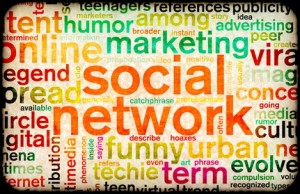
 Social media is hype.
Social media is hype.
At seminars and workshops you can hear the phrase bouncing around, Twitter is flooded with the term, and new job titles frequently appear that are based on it. But is social media the holy grail for the marketing and communications industry? Is social media THE solution for brands who cannot reach their customers anymore?
No…
Social media, or social marketing, is a strategic direction for brands to follow. But it is not the only right way to go in the current Zeitgeist. There are other strategies to communicate messages to your target group and obtain a position in their evoked set; even in times like these when it has become hard to reach them.
Social media isn’t a strategy
I often hear companies say they want to do something with social media, without realizing what they want to accomplish and forgetting to set goals. A lot is written about statistics, underlying systems and techniques of successful examples to discover principles. Much of this is based on volatile information, because tomorrow there is always a next big thing. Rarely is social media addressed from a brand perspective. What does social media mean for my brand strategy?
Also, social media often is confused with strategy. Literally, social media relates to means. And means have nothing to do with strategy or strategic directions. Social marketing would be more appropriate in this context: facilitating social needs of target groups from a brand strategy perspective.
Think of questions like: What kind of social needs do my customers have? Can my brand play a role in fulfilling these needs? Which needs match my brand values and communication goals? Is my brand plausible to fulfill this need of my customers?
These kind of questions should be answered first before creating that new cool social platform.
Social media is sometimes undesirable.
A social marketing strategy can be powerful, but isn’t always the right way to go for brands. Maybe the target group isn’t characterized by self-expression, or doesn’t want to socially interact with each other, take for example some business-to-business markets. And it is this need for social interaction that is essential for creating a successful social platform.
Also, sometimes the social needs of a target group can be too different from the values of a brand. Specifically, the link between social need for interaction and the brand values is essential for a successful communication strategy. In other words; The target audience must be able to comprehend the relation between the fulfillment of a social need and the brand, otherwise a preferred place in the mindset of your target audience cannot be accomplished.
Furthermore, for an organizational point of view, it can be undesirable to choose a social marketing strategy. It’s hard work to facilitate a successful platform for a social need. A lot of time, energy and commitment is needed to be successful. Social media isn’t a fully discovered area of interest and a pioneer and flexible attitude is required. And not every organization wants to allocate sufficient budget or time for this.
Should we stick to the old model?
No. One thing is for sure, the traditional way of advertising isn’t good enough anymore. Buying GRPs and trying to repeat your message as much as possible doesn’t work anymore. Consumers are fed up with meaningless advertising and cheap marketing. Brands have to show in their communication why a consumer should give his or her attention.
How?
With communication that is relevant and meaningful to your customers’ life
Appealing to only an emotion or a domain isn’t sufficient anymore for a brand to be distinctive and memorable. Due to media fragmentation and the internet, consumers have more power regarding the information they want to consume. Think for example of banner blindness or zapping away behavior during TV-breaks. According to Nielsen research (http://www.slideshare.net/PingElizabeth/nielsen-trust-and-advertising-global-report-july09) people only trust 14% of advertisements. They have seen enough cosmetic and superficial advertisements from insurance companies that proclaim freedom, breakfast producers claiming happy families or car companies that appeal to successful living, without really proving it and being valuable.
Brand communication has to offer something more for a consumer, in order to be receptive for a brand. By offering something that makes the life of your consumer nicer or easier, brands can stand out from the clutter and get the required attention and even loyal customers. Communication should focus on the needs of a target group to get engaged and loyal customers.
As Trevor Edwards, vice president Global brand & category management Nike, puts it:
“We are not in the business of supporting a media industry, we are in the business of connecting with customers.”
Advertising and marketing should focus more on the social needs of the customers’ lives instead of creating that perfect print ad or optimizing that last bit of their banner strategy. Or put in a different way: advertising should focus on servicing instead of promotion. This kind of communication requires new skills for the marketing department and ad agencies. Not only is the know-how of marketing required, but also knowledge of innovation and an understanding of psychological and social needs.
Read Find a Marketing Technopolist from the WSJ or Making Meaning from Nathan Shedroff, both very insightful.
Is relevant and meaningful communication something new?
No, not really. Being a relevant and valuable brand isn’t something new. Some brands choose to be relevant in the pre-internet era. Think of Michelin and their restaurant reviews, being THE authority for exclusive restaurants. Or what about the second most sold book worldwide after the bible: Guinness Book of Records, created by the Guinness beer brewery. Companies have tried to be relevant and meaningful in their communication. But because of the media dominance of the last century, companies could buy their reach on TV, print and radio and were able to be sure enough people saw their ad. Therefore, their communication didn’t need to be really valuable, they got their reach anyway.
Despite the fact that relevant and meaningful communication is not really new, the internet gives a new dimension to this way of advertising. Think about word-of-mouth, communication- and sharing tools, these improve the impact of relevant and meaningful communication and also create new innovative opportunities. Also the costs for servicing decreases significantly because of economies of scale principles. Think of how expensive it would be for Nike to help runners with their training techniques and progress without the Nike+ platform. Take into account the rapidly decreasing results of push advertising and you will see that relevant and meaningful communication are or will be on top of the brand manager’s list.
How does social media relate to meaningful communication?
So, marketing and advertising should be more relevant by servicing customers’ needs in order to get their attention and loyalty. But how does that relate to the social media phenomenon?
Well, social media facilitates social needs between people and therefore it is relevant and meaningful in this context. Think of Linkedin for business networking or 43things (www.43things.com) for setting and sharing life goals. Also brands can be a relevant participator of facilitator in these platforms. They can facilitate social needs of their target group that match with their brand values.
But there are other ways for a brand to be relevant and meaningful without focusing on social needs. Besides social relevance a brand can be functional or contextual relevant.
Social relevance
The best known type of relevance is social relevance. Brands can be socially relevant for consumers by adopting a social marketing strategy. The focus lies on facilitating social needs.
Think of the well-known Nike+ running (www.nikeplus.com), which helps runners practice their sport by facilitating experiences with each other and strengthen the competitiveness value of the brand.
Also think of other specific interest groups, take for example CFvoice (www.CFvoice.com) initiated by Novartis, an online community for people living with cystic fibrosis and connecting with each other. This platform makes Novartis a more caring and evolved brand, it also gives Novartis valuable insight in the lives of people living with the disease and their cares.
Functional relevance
Brands can be functional relevant for consumers. Providing a service that is useful makes a loyal customer, this concept is also known as branded utility or brand utility.
Take for example the Ifood Iphone app (http://www.kraftfoods.com/kf/iFood.aspx) from Kraft; It helps customers to find recipes for inspiration during shopping and create a shopping list based upon it. The Dutch Iphone App “Appie” takes this service a step further, they are going to create shoppinglist that is based on the routing of the supermarket nearby, so you walk the most efficient route in your supermarket with your online grocery list.
Another example is the Teamlink application of the Dutch beer brewer Amstel. The application helps amateur football players with managing their team. It provides statistics of matches, it has an attendance list for upcoming matches en players can tell who is responsible for doing the laundry or will drive to the next away game. All this lies in line with the friendship and fun brand values of Amstel.
Contextual relevance
Context is becoming more important. With the internet and mobile we can create more valuable information because of the context or location. Mobile applications such as Foursquare or Layar take contextual relevance to the next level.
An example of contextual information I worked on is the social platform Iederzijnrol (soon to be launched)for the City of Rotterdam in the Netherlands. The social platform is based on a Google Maps application where participants can deliver suggestions about where and how to improve their council. They can discuss en judge ideas as well. It also provides the city a platform to show what they have undertaken in each council. In this way, residents can participate in the safety of their council and can see what is done by the city in their particular neighborhood. This context of neighborhood makes it more relevant than the general and often meaningless ads on a city level.
Summing up
Brands that are relevant and meaningful, have a sustainable relation with their target group. That’s something really valuable in times when you cannot buy the required attention of you customer anymore. In which way a brand wants to be relevant or on what level depends on its strategy. Internet is often an important facilitator for this relevance.
Finding and proving to be relevant and to be compliant with the values of a brand and strategy takes requires a new set of skills. Not only communication skills are required, also knowledge of innovation and an understanding of social needs are of importance. Ad agencies that foster these three areas can be of great value, but are still scarce. But being relevant and meaningful for your target group can be really profitable; Having a sustainable relationship with your customer makes a loyal customer and that creates a great competitive advantage.
Get the TNW newsletter
Get the most important tech news in your inbox each week.





